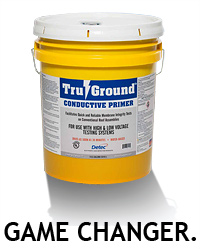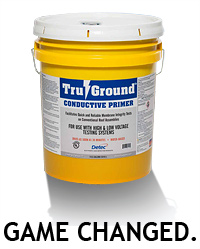Whether you're troubleshooting an emergency or enhancing the safety and reliability of mission critical systems, we're ready to provide the professional inspection and analysis you need. More


 |
 |
|||||
| Electronic Leak Detection: ELD Fusion®, Low Voltage, and High Voltage |
|||||||||||||||||||||||||||||
 Now you can specify a conductive layer DIRECTLY UNDER the membrane that doesn’t risk compromising adhesion. TruGround™ ensures a quick, thorough, and accurate membrane integrity test can be performed on insulated systems. More.. |
TruGround™ is the best way to make sure the waterproof membrane on your conventional roof assembly is dry and watertight. For use with both high and low voltage testing methods. Get full testability and full adhesion—install the closest, most complete grounding substrate for the entire membrane. More..  |
||||||||||||||||||||||||||||
Electric vector mapping is a cutting edge technology that is redefining the art of leak detection and quality assurance in low-slope roofing and waterproofing systems. Low Voltage Vector Mapping is a method of electronic leak detection that pinpoints breaches in the roof membrane by tracing the flow of an electric current across the membrane surface. Already Europe’s most widely-used method for detecting roof leaks, vector mapping is rapidly being adopted by manufacturers, contractors, and specifiers in the United States. Electronic Leak Detection eliminates the dangers and potential damage inherent in traditional flood testing. Unlike the interpretive process of water, flood, infrared, or nuclear testing, vector mapping detects membrane faults directly. It is ideal for quality and warranty assurance needs, for leak testing of green (vegetative) and ballasted roofs, and for leak detection in all low-slope roofing systems in which the membrane is not electrically conductive and the deck can be electrically grounded. Even pinhole leaks invisible to the naked eye can be pinpointed with Electronic Leak Detection, and repairs can be made on the spot and immediately retested to ensure watertight results.
ELD Fusion®: Traditional Low Voltage Vector Mapping is an accurate and reliable technique for integrity testing on large, wide open areas. But standard low voltage methodology does not typically test many of the areas that require the most careful and conscientious work – parapets and curbs, flashings, and transitions from horizontal to vertical surfaces. Now you can get virtually 100% testing on your work with ELD Fusion®, our unique combination of High and Low Voltage Electronic Leak Detection methodologies. ELD Fusion combines traditional Low Voltage Vector Mapping (wet testing) on large horizontal areas with High Voltage ELD (dry testing) on vertical surfaces, transitions, and other areas not typically tested with the low voltage technique. ELD Fusion gives you 100% coverage – and 100% peace of mind that your membrane will be leak free. Download our free specifications
Low Voltage Vector Mapping: In low voltage vector mapping, the surface of the roof membrane is moistened (not flooded) to create an electrically conductive medium. A conductive wire loop is laid on the membrane around a section of the area to be tested. One lead from a pulse generator is connected to this wire loop perimeter. The other lead from the generator is connected to the structural roof deck. Leaks or breaches in the membrane are detected when the electric current flows across the membrane and down through the breach to the deck, completing the circuit. The technician uses two probes connected to a receiver to determine the direction of the electric current and precisely locate the breach. Diagram of Low Voltage Vector Mapping Download our free specifications High Voltage Electronic Leak Detection: High voltage testing is performed on a dry horizontal or vertical surface using a very small current at relatively high voltage for safe and reliable testing. One lead from the portable current generator (charger) is grounded to the roof deck (either metal or concrete) or foundation walls. The other lead is attached to a special electrode brush made with highly conductive metal bristles. As the technician “sweeps” the brush electrode over the surface of the roof membrane, electricity will flow through any breach in the membrane, completing a circuit between the brush and the roof deck. Where there are no breaches, the membrane acts as an insulator and prevents the flow of current to the deck. Download our free specifications Electronic Leak Detection benefits:
• Pinpoints membrane defects for efficient repair Electronic Leak Detection applications:
• Insulated and non-insulated low-slope roof systems
(excluding metal-coated |
|||||||||||||||||||||||||||||
| Call
800-879-1964 today to get a free quote for a test of your roofing or waterproofing installation. |
|||||||||||||||||||||||||||||
| For
more information, download our ELD Fusion, Low
Voltage Vector Mapping and High
Voltage ELD brochures. Read our article in RCI Interface: Electronic Leak Detection: The Future of Membrane Integrity Testing |
|||||||||||||||||||||||||||||
| Serving the Special Needs of Your Industry: | |||||||||||||||||||||||||||||
|
|||||||||||||||||||||||||||||
|
|||||||||||||||||||||||||||||
|
|||||||||||||||||||||||||||||
|
|||||||||||||||||||||||||||||
| USGBC
and related logo is a trademark owned by the U.S. Green Building
Council and is used with permission. All other content copyright © 2003 - 2019 Infra-red Analyzers, Inc. |
|||||||||||||||||||||||||||||